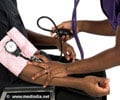According to Penn State Hershey Heart and Vascular Institute researchers low levels of antioxidants contribute to increased blood pressure during exercise for people with peripheral blood pressure.

"Past studies have shown that having low antioxidant levels and increased reactive oxygen species -- chemical products that bind to body cells and cause damage -- is related to more severe PAD," said Matthew Muller, postdoctoral fellow in Dr. Larry Sinoway's lab at Penn State College of Medicine, and lead author of the study.
Antioxidants prevent the reactive oxygen species from damaging cells.
"This study shows that blood pressure increases more with exercise in more severe PAD cases. By infusing the antioxidant vitamin C into the blood, we were able to lessen the increase in blood pressure during exercise," said Muller.
Vitamin C does not lessen the increase in blood pressure of PAD patients to that of healthy people. As the intensity of exercise increases, the effects of vitamin C decrease but are still seen. The researchers report their findings in the Journal of Physiology.
Penn State Hershey researchers looked at three groups of PAD patients to study the blood pressure increase. A group of 13 PAD patients was compared to people without PAD to see the effects of doing low-intensity exercise on blood pressure. From that group, a second group of nine patients was used to measure the effects of vitamin C. A third group of five PAD patients and five without PAD had their leg muscles electrically stimulated to remove the brain's role in raising blood pressure during muscle contraction in this disease.
Advertisement
Advertisement
Source-Eurekalert















